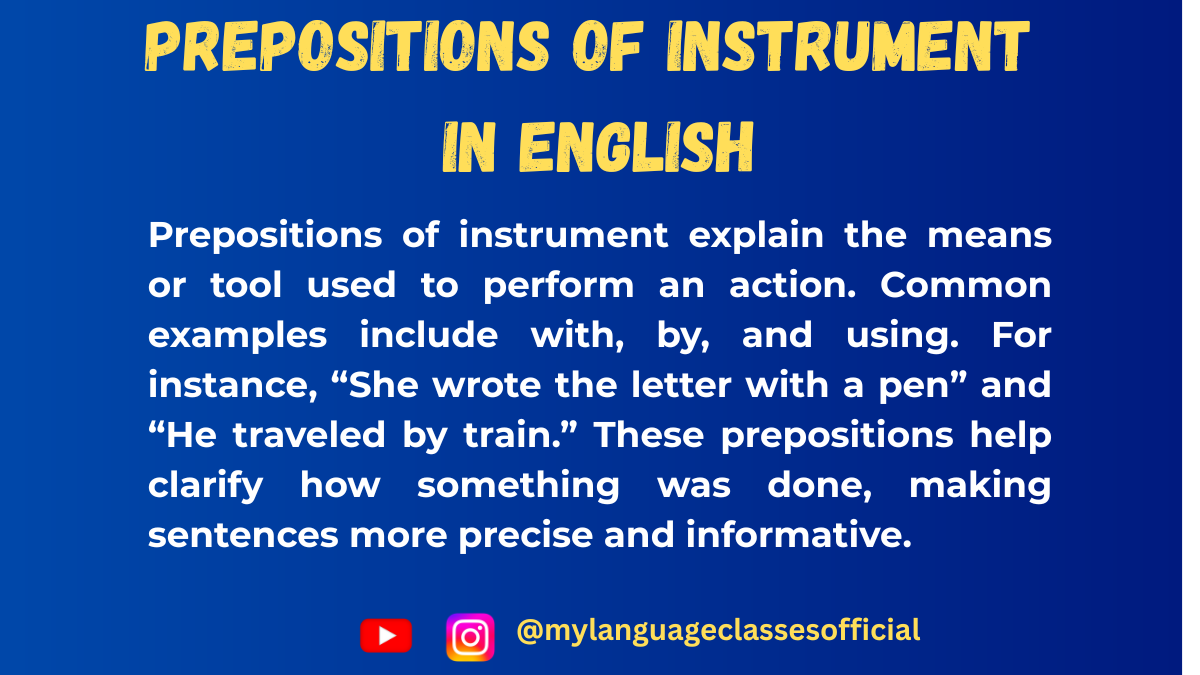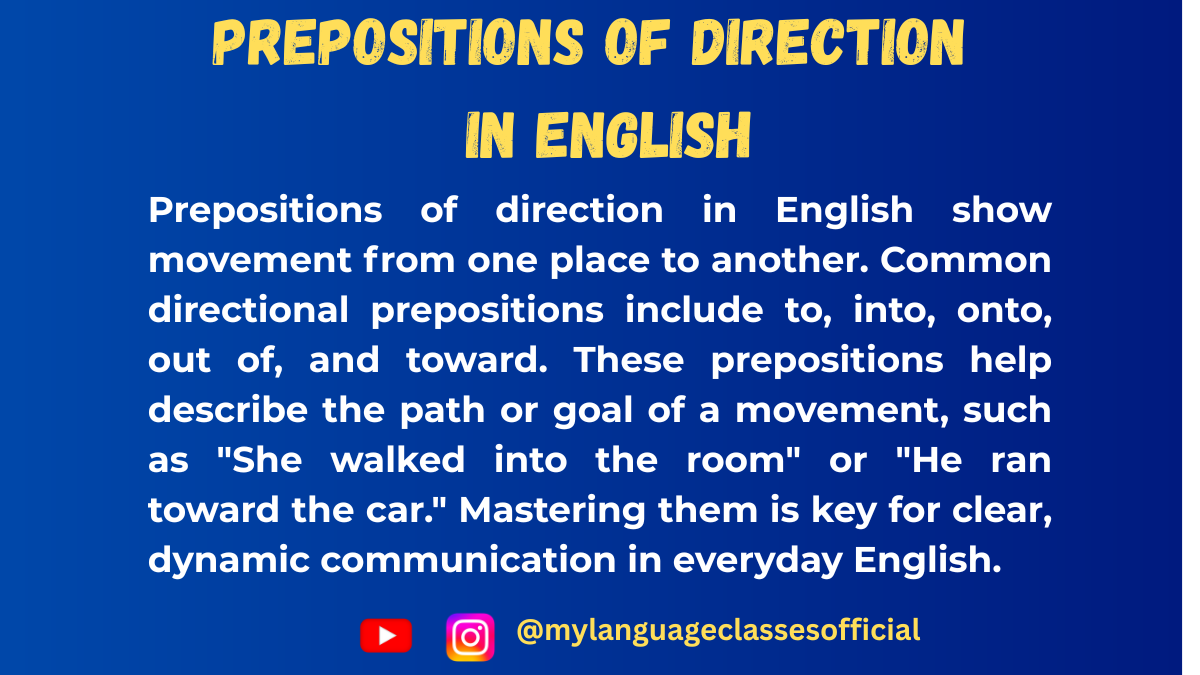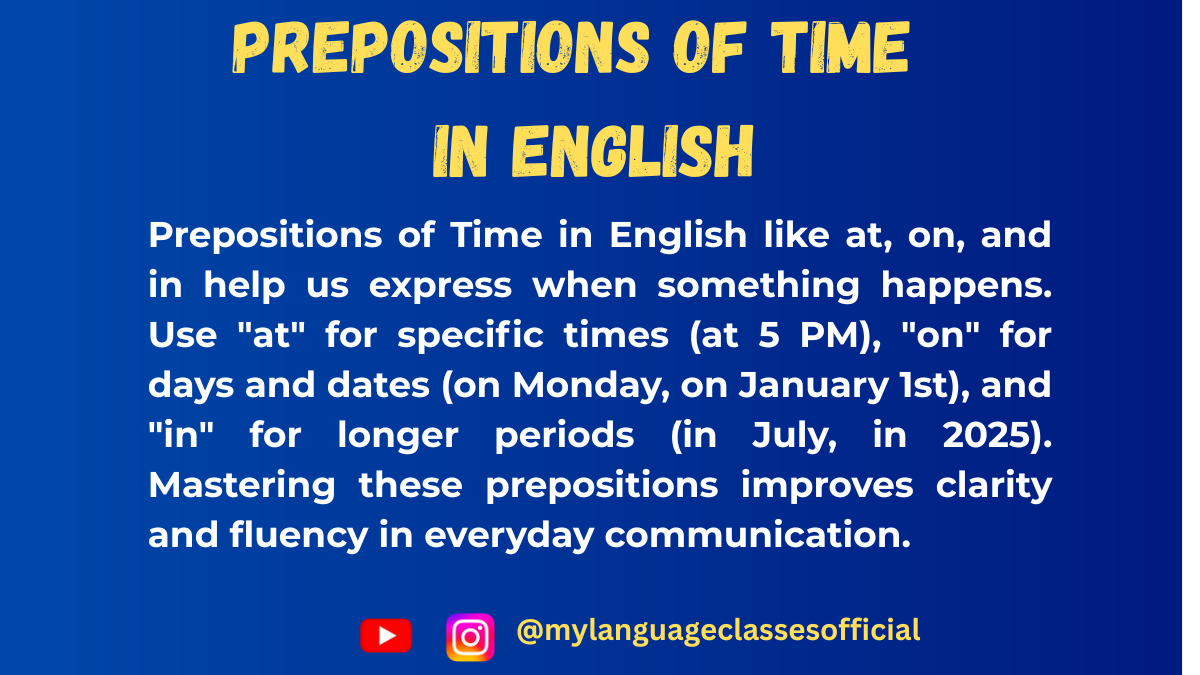Your cart is currently empty!
Tag: United Kingdom
-

Prepositions of Instrument in English
Prepositions of instrument are used to indicate the means or tools used to perform an action. These prepositions show how something happens or is achieved. They are crucial in English grammar, as they help provide clarity in sentences.
Usage of Prepositions of Instrument
Prepositions of instrument are used in various situations, such as:
- With Tools or Instruments – Used when referring to a tool or instrument that helps complete an action.
- With Modes of Transport – Used when talking about how someone travels.
- With Means of Communication – Used when referring to ways of sending or receiving information.
- With Body Parts – Used when describing actions performed using body parts.
- With Natural Forces – Used when mentioning how something is affected by nature.
- With Materials or Substances – Used to describe the material used to create something.
- With Assistance – Used when referring to a person or thing that helps achieve something.
- With Measurement and Currency – Used when expressing amounts or ways of measuring.
List of Prepositions of Instrument
Preposition Example Sentence 1 Example Sentence 2 by She wrote the letter by hand. He traveled by car. with He cut the paper with scissors. She painted the wall with a brush. through They communicated through email. The water flows through the pipe. using He solved the problem using a calculator. She opened the door using a key. by means of The data was transferred by means of a USB drive. He escaped by means of a secret tunnel. via The message was sent via email. We traveled via London. on She swore on her mother’s life. He played a song on the piano. in The message was written in ink. She expressed her feelings in words. through the use of The document was signed through the use of an electronic pen. The problem was solved through the use of technology. by way of They reached the village by way of the river. He sent the package by way of courier.
More Example Sentences
- She cut the vegetables with a sharp knife.
- He sent me a message via WhatsApp.
- The report was written in pencil.
- We traveled to the city by train.
- He operates the machine using a remote control.
- She delivered the speech through a microphone.
- The bridge collapsed by means of an explosion.
- The poem was written on a piece of parchment.
- The artist sketched the portrait with charcoal.
- They recorded the lecture through the use of a digital recorder.
Fill in the Blanks
- He fixed the broken chair ___ a hammer.
- She traveled to Paris ___ plane.
- The students communicated ___ email.
- He ate the soup ___ a spoon.
- The announcement was made ___ a loudspeaker.
- The letter was written ___ a ballpoint pen.
- They cut the paper ___ scissors.
- The transaction was completed ___ an online payment system.
- The thief entered the house ___ a secret passage.
- The message was transmitted ___ radio waves.
Answers
- with
- by
- through
- with
- through
- in
- with
- using
- by means of
- via
Things to Keep in Mind
- Prepositions of instrument often indicate the method, means, or tools used to perform an action.
- Some prepositions, like by and with, are commonly interchangeable but depend on context.
- The choice of preposition can sometimes depend on the verb in the sentence.
- Articles (a, an, the) may be required before the instrument (e.g., “with a knife”).
- Gender does not play a role in English prepositions, unlike some other languages.
Conclusion
Prepositions of instrument are essential in English to convey how actions are performed. Understanding their correct usage will help improve clarity and precision in communication. By mastering these prepositions, learners can express themselves more effectively in various situations, whether discussing tools, travel, communication, or assistance.
If you enjoyed this lesson, be sure to check out more posts like this on my blog at My Language Classes. Don’t forget to subscribe my YouTube channel and follow me on Instagram for the latest language learning tips and lessons. Leave a comment below to share your thoughts, or ask any questions you have about nouns.
Happy learning! 😊
-

Prepositions of Direction in English
Prepositions of direction indicate movement from one place to another. They are essential in describing how something moves or changes position concerning another object.
List of Prepositions of Direction and Their Usage
Preposition Meaning Example Sentence 1 Example Sentence 2 To Movement towards a destination She went to the park. He sent a letter to his friend. Into Movement from outside to inside She walked into the room. The cat jumped into the box. Onto Movement towards a surface The child climbed onto the table. He jumped onto the bed. Out of Movement from inside to outside She ran out of the house. He took his phone out of his pocket. Towards Movement in the direction of something She moved towards the door. He walked towards me with a smile. Away from Movement in the opposite direction She walked away from the fire. The dog ran away from the stranger. Up Movement from a lower position to a higher one He climbed up the hill. The plane soared up into the sky. Down Movement from a higher position to a lower one The ball rolled down the hill. She walked down the stairs. Across Movement from one side to another He swam across the river. The children ran across the street. Over Movement above something The bird flew over the lake. He jumped over the fence. Under Movement beneath something The dog crawled under the table. The ball rolled under the chair. Along Movement following a path He walked along the beach. The car drove along the highway. Past Movement beyond a certain point They walked past the school. He drove past the mall. Through Movement within a space from one end to another She ran through the tunnel. The wind blew through the trees. Around Movement in a circular direction He walked around the park. The car drove around the roundabout.
More Example Sentences
- The boy ran to his mother as soon as he saw her.
- She poured the coffee into the cup carefully.
- He jumped onto the boat from the dock.
- The cat ran out of the house when the door was open.
- The athlete sprinted towards the finish line.
- They moved away from the dangerous area.
- The monkey climbed up the tree quickly.
- She walked down the street, enjoying the fresh air.
- He drove across the city to meet his friend.
- The plane flew over the mountains.
Fill in the Blanks
- She jumped ___ the swimming pool.
- He walked ___ the tunnel to reach the other side.
- The dog ran ___ the street to chase the cat.
- The helicopter flew ___ the buildings.
- He climbed ___ the ladder to fix the roof.
- The train passed ___ the bridge.
- The girl moved ___ the stage to receive her award.
- The kids walked ___ the road to reach school.
- The car drove ___ the highway without stopping.
- He ran ___ the hill with great speed.
Answers:
- into
- through
- across
- over
- up
- over
- towards
- across
- along
- down
Things to Keep in Mind
- Prepositions of direction always describe movement from one place to another.
- Some prepositions like to and towards may seem similar but have different uses (e.g., “to” specifies the destination, while “towards” indicates movement in a direction without necessarily reaching the destination).
- Prepositions such as into and onto describe entering or moving onto a surface, while in and on describe static positions.
- Over and under describe movement above and below something, respectively.
- Across and through both describe movement, but “across” is typically for flat surfaces, while “through” indicates movement within an enclosed space.
Conclusion
Prepositions of direction are essential for clear communication when describing movement and changes in position. Understanding their proper usage will enhance both written and spoken English. By practicing these prepositions in different contexts, you can develop a natural sense of their application and improve your fluency. Keep practicing with more sentences and exercises to master this important grammar topic!
If you enjoyed this lesson, be sure to check out more posts like this on my blog at My Language Classes. Don’t forget to subscribe my YouTube channel and follow me on Instagram for the latest language learning tips and lessons. Leave a comment below to share your thoughts, or ask any questions you have about nouns.
Happy learning! 😊
-

Prepositions of Time in English
Prepositions of time are essential in English grammar as they help us understand when an event occurs. They connect nouns or pronouns with time-related elements, clarifying specific moments, durations, or general time frames. In this blog, we will explore the different prepositions of time, their usages, examples, and important points to remember.
List of Prepositions of Time and Their Usage
Below is a list of common prepositions of time along with their specific usage and example sentences.
Preposition Usage Example Sentence 1 Example Sentence 2 At Specific time of the day, festivals, and specific points in time I wake up at 6 AM. We will meet at Christmas. On Specific days and dates I was born on Monday. The party is on 5th June. In Months, years, centuries, long periods I was born in December. We will visit Japan in 2025. By A deadline or before a certain time You must submit the report by Monday. She will be home by 7 PM. Before An event occurring earlier than a certain time Finish your work before sunset. He arrived before me. After An event occurring later than a certain time We will go out after lunch. She arrived after the meeting started. Since A point in time until now She has been here since morning. I have lived here since 2010. For Duration of time She stayed here for two weeks. I have known him for ten years. During Within a specific period He slept during the lecture. We traveled during the holidays. From…to A specific time range The shop is open from 9 AM to 5 PM. The movie runs from 6 PM to 8 PM. Until/till Up to a certain point in time Wait here until I return. The shop is open till midnight. Within Before the end of a specific period The work will be done within an hour. We will reach there within two days.
More Example Sentences
- She will call me at noon.
- The meeting is scheduled on Tuesday.
- We moved to this city in 2018.
- Complete your assignment by tomorrow.
- The baby slept before dinner.
- We will go out after the rain stops.
- She has lived here since 2015.
- He was on vacation for a month.
- The crowd cheered during the match.
- The library is open from 9 AM to 7 PM.
Things to Keep in Mind
- At is used for specific points in time, while on is for specific days and dates.
- In is used for months, years, centuries, and longer periods.
- Since refers to a specific point in time, while for is used for a duration.
- By means “no later than,” whereas before means “earlier than.”
- Until/till is used when something continues up to a point in time.
- From…to marks the beginning and end of a time period.
- During is used to indicate something happening within a specific period.
- Within suggests a task or event will occur before a given period ends.
Fill in the Blanks
- The train will arrive ___ 6 PM.
- She was born ___ March.
- We will go on a trip ___ summer vacation.
- He stayed in London ___ two years.
- You should submit the form ___ Monday.
- The lights went out ___ the movie.
- I have been waiting here ___ morning.
- We will complete the project ___ two weeks.
- They will be back home ___ midnight.
- The concert will be held ___ Friday night.
Answers
- at
- in
- during
- for
- by
- during
- since
- within
- at
- on
Conclusion
Understanding and correctly using prepositions of time is crucial for clear and precise communication. These prepositions help in framing accurate sentences, making conversations and writing more effective. By practicing their usage and remembering their specific contexts, you can enhance your command over the English language. Keep practicing, and soon, using prepositions of time will become second nature!
If you enjoyed this lesson, be sure to check out more posts like this on my blog at My Language Classes. Don’t forget to subscribe my YouTube channel and follow me on Instagram for the latest language learning tips and lessons. Leave a comment below to share your thoughts, or ask any questions you have about nouns.
Happy learning! 😊
